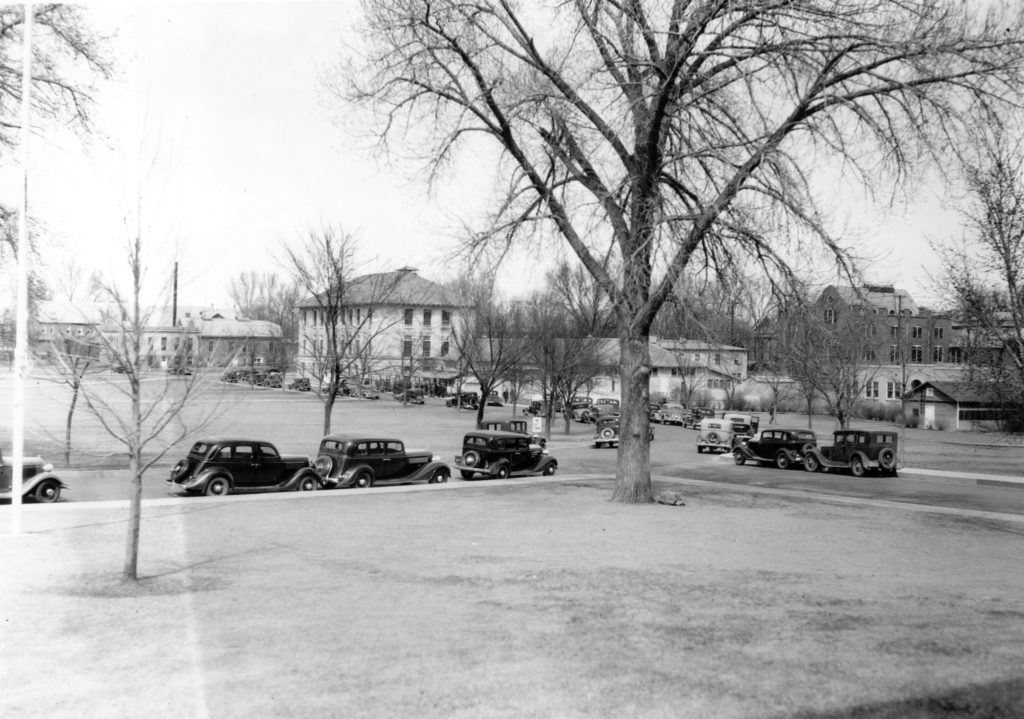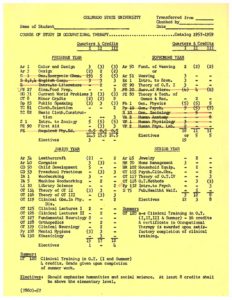
Story by Rachel Sipes
Coming to the University campus in the early 1900s looked much different than the transportation of today with modern cars and bus systems; however, some form of transportation would have been important for everyone. This three-story building on Colorado State University’s historic Oval, occupied at that time by the physics department, has been the home of the Department of Occupational Therapy since 1987. This academic year, while CSU celebrates it’s Sesquicentennial, the building celebrates 100 years and the CSU OT program 75 years since the major began in 1945.
What is occupational therapy?

Although occupational therapy was not offered as a program on the CSU campus 100 years ago, the occupational therapy profession is over 100 years old and has always centered on helping people participate fully in daily life. This participation in daily life may look different for various people. A baby’s day may consist of the activities (occupations) of eating and playing whereas an adult’s day may include going to school, working and various hobbies such as biking or playing an instrument. Everyone has occupations. However, sometimes there can be barriers, both with a person’s physical or cognitive limitations and within the environment, which can limit a person’s full participation in their occupations.
Across the decades

Occupational therapy officially began in 1917 due in part to so many people coming home from the world wars with life altering injuries, both mentally and physically; however, the occupational therapy program at CSU had yet to become established until 1945. Needless to say, the curriculum at that time was very different than today. In the beginning the department offered a bachelor’s program in which women graduated with a degree in occupational therapy and home economics. Men graduated with a degree in occupational therapy and industrial arts.
As Janice Condon, (B.S. ’64) shared, “I remember I loved most of the curriculum except home economics in which we were taught to iron a man’s shirt and then timed to pass in three minutes.”
She continued, “Also, we studied psychology, neurology and anatomy and lab, physiology and occupational therapy theory. Arts and crafts were taught including two quarters of woodworking, metal shop, weaving, sewing, art and ceramics. I believe there were 12 occupational therapy students in our class, and after a year at Fort Collins we spent two quarters at Denver Medical School.”
Her education and years as an occupational therapist have obviously been rewarding as Condon happily shared that her passion and love of occupational therapy continues. After many years, she still works part-time in home health and a skilled nursing facility.
Miriam Sakurada Cake (B.S., ’76) shared that her experiences in the program of 80 students not only included courses in anatomy, neurology and dissection labs but also hands-on classes in the industrial sciences department such as woodshop, plastics and metals. “We needed to know how to run band saws, planers for woodcraft, metalcraft, leathercraft, silk screening and linoleum block printing,” she said.
From undergraduate to graduate programs

Although a bachelor’s degree is no longer awarded and classes in arts and crafts are no longer offered, the department offers an entry-level master’s program which began in 1985. In addition to students gaining experiences through fieldwork that has existed since the beginning of the program, today students have many new opportunities such as learning about technology and adaptive equipment and working in community settings with emerging and diverse client populations.
Students are also involved with local community organizations, helping a variety of populations, such as people experiencing homelessness, those suffering from opioid misuse and people in the legal system. Students are surrounded by innovative research occurring within the department as well as opportunities to be involved in outreach programs such as the Center for Community Partnerships and the Assistive Technology Resource Center. Looking forward, the department now awaits final approval to offer an OTD program in the near future.
Throughout these changes, the profession’s main purpose of helping people participate more fully in daily life stays at the center of it all. As one of our OT alumna shared, “Ask questions like ‘What if?’ As this question will open up new possibilities. Occupational therapists have the ability to change lives, and that is what OT is about.”
Throughout the building

Not only has the curriculum developed and changed over the years, there have been many changes within the building. The flood of 1997 left six feet of flood waters on the first floor and resulted in one of several renovation projects over the years. In other projects the kiln was removed, faculty offices were moved, classrooms were enhanced, orange carpet was replaced and an adaptive garden was built.
When asked about her experiences as staff in the department, Linda McDowell shared, “I remember when we were introduced to emails and the internet. Things have really changed. Many of them have been for the better and at times I wonder how I lived without them.”
Although many things have changed over years with students graduating, new programs being offered, curriculum being enhanced, new research being conducted and centers being advanced, this only provides greater opportunities for CSU-OT as it continues to press forward and be excited for the future of the program and the profession.
The Department of Occupational Therapy is part of CSU’s College of Health and Human Sciences.